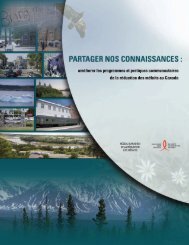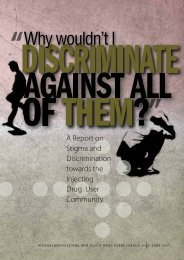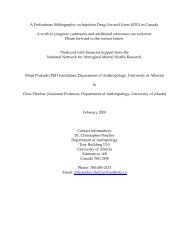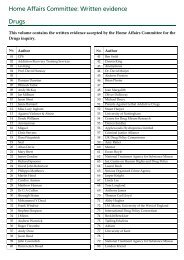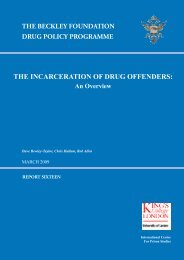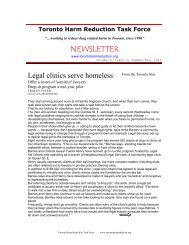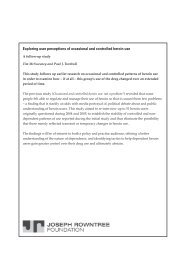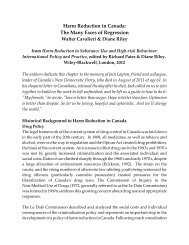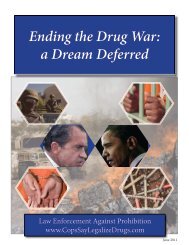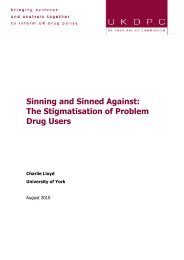Superior Points HRP - Canadian Harm Reduction Network
Superior Points HRP - Canadian Harm Reduction Network
Superior Points HRP - Canadian Harm Reduction Network
You also want an ePaper? Increase the reach of your titles
YUMPU automatically turns print PDFs into web optimized ePapers that Google loves.
<strong>Superior</strong> <strong>Points</strong><strong>Harm</strong> <strong>Reduction</strong> ProgramHARM REDUCTIONTRAINING PROTOCOLSforStaff, Volunteers, andCommunity Agencies
Prepared by:Stacey Hare Hodgins, HBSW Student,Edited by Don Young, Program Manager,<strong>Superior</strong> <strong>Points</strong> <strong>Harm</strong> <strong>Reduction</strong> Program (SP<strong>HRP</strong>).Acknowledgments:SP<strong>HRP</strong> gratefully acknowledges Shaun Hopkins, Manager of The Works inToronto, for sharing the protocols that helped create a solid foundation forthis document. We also wish to acknowledge Stuart Boland, IDUO Workerof AIDS Thunder Bay, and Ron Shore, Manager of Kingston Street Health,for their peer review of this document.SP<strong>HRP</strong> also would like to acknowledge the support of Darlene Binette,Manager of Infectious Disease Thunder Bay District Health Unit, the Boardand senior management of the Thunder Bay District Health Unit. Withouttheir support and dedication to harm reduction, SP<strong>HRP</strong> would have neverbeen the success it is today.Thank you to Mike DeProphetis, Stacey’s off-site Field PlacementSupervisor, and Jill Zachary Lakehead University School of Social Work FieldEducation/Admission Coordinator for their understanding of the uniquedynamics of this placement setting. Rick Thompson, Senior OutreachWorker, and Lori Franzen, Outreach Worker, both of SP<strong>HRP</strong> for theirinvaluable input and for being a resource at all times in the development ofthis manual. SP<strong>HRP</strong> also wishes to thank the numerous volunteers and allthe partner agencies affiliated with this program.We would also like to take this opportunity to acknowledge the skills andthe amazing talents and knowledge of the clients of SP<strong>HRP</strong> to whom thisprogram belongs.THIS ENTIRE MANUAL IS ANTI-COPYRIGHTED AND FREE FOR DUPLICATION ORADAPTATION BY OTHER HARM REDUCTION INITIATIVES! PLEASE ACKNOWLEDGESP<strong>HRP</strong> OR APPROPRIATE SOURCES WHEN REPRODUCING ANY PART OF IT.For more information regarding this manual contact:<strong>Superior</strong> <strong>Points</strong> <strong>Harm</strong> <strong>Reduction</strong> ProgramThe Village Clinic502 E. Victoria AvenueThunder Bay, ON P7C 1A7Office • (807) 624-2005Fax • (807) 622-6195Email • don.young@tbdhu.comrick.thompson@tbdhu.comlori.franzen@tbdhu.comwww.tbdhu.comSUPERIOR POINTS HARM REDUCTION PROGRAMProtocols for Staff, Volunteers and Community Agencies1
August 2005CONTENTSINTRODUCTION 5PHILOSOPHY 6DEFINING HARM REDUCTION 7<strong>Superior</strong> <strong>Points</strong> <strong>Harm</strong> <strong>Reduction</strong> Program 9SAFETY PRACTICES & PROCEDURES 11Universal Precautions 11Personal Protective Equipment 12Sharps Containers 12Preparing Full Sharps for Disposal13Handling a Needle or Syringe 14Handling a Used Condom 14Needle-stick Injuries 15Vaccinations 16HARM REDUCTION SUPPLIES 17<strong>Superior</strong> <strong>Points</strong>’ Supplies & Inventory 18DIRECT CLIENT SERVICES 21How to Use the <strong>Superior</strong> <strong>Points</strong> Tracking Form 22NEEDLE EXCHANGE PRACTICES & PROCEDURES 23Needle Distribution 23Needle Recovery24CRITICAL INCIDENTS 25Crisis Response 25Child at Risk 25Police Involvement 25SUPERIOR POINTS HARM REDUCTION PROGRAMProtocols for Staff, Volunteers and Community Agencies2
NEEDLE EXCHANGE SITE-SPECIFIC INFORMATION 26BIBLIOGRAPHY 27Websites 27Articles, Manuals, Texts 29APPENDICES 32Appendix A • Site Inventory Control Sheet 32Appendix B • <strong>Superior</strong> <strong>Points</strong> Tracking Form 33Appendix C • Safe Streets Act, 1999 34Appendix C • Duty to Report Legislation 36Appendix E • Hepatitis C Prevention Tips 37Appendix F • Safer Injection Tips 38Appendix G • Solvent Use Tips 40Appendix H • Safer Crack Use Tips41ADDITIONAL SOURCES OF INFORMATION 42<strong>Superior</strong> <strong>Points</strong> NEP Sites 42<strong>Harm</strong> <strong>Reduction</strong>/Needle Exchange Programs 43HIV/AIDS Resources 45Hepatitis C (HCV) Resources 46Local Substance Use/Addictions Resources 47HARM REDUCTION COALITION BROCHURES 48Safer Injection – Arteries 48Safer Injection – The Right Hit 50Safer Injection – Levels of Risk 52Safer Injection – Rotate Your Spot54Safer Injection – Think Sink Hygiene 56SUPERIOR POINTS HARM REDUCTION PROGRAMProtocols for Staff, Volunteers and Community Agencies3
<strong>Harm</strong> reductionis a way of thinking about and practicinghealthy ways of beingthat build on the risk reduction strategieswe all use to keep ourselvesas safe and healthy as possible(T.R.I.P. – Toronto Raver Info. Project)SUPERIOR POINTS HARM REDUCTION PROGRAMProtocols for Staff, Volunteers and Community Agencies4
INTRODUCTIONThe following information is intended as direction for the staff andvolunteers of <strong>Superior</strong> <strong>Points</strong> <strong>Harm</strong> <strong>Reduction</strong> Program (SP<strong>HRP</strong>) and thecommunity agencies providing needle exchange and other harm reductionservices under contract with the Thunder Bay District Health Unit (TBDHU).For the purposes of this manual, the term ‘staff’ is meant to include paidstaff, volunteers and students on field placement.The page covering Universal Precautions, as well as most of theappendices, is designed for photocopying and posting for staff at individualneedle exchange sites and/or distributing to clients. Nevertheless, thisentire manual is anti-copyrighted and free to duplicate.This harm reduction training manual provides:• An explanation of harm reduction• An overview of <strong>Superior</strong> <strong>Points</strong> <strong>Harm</strong> <strong>Reduction</strong> Program• Instructions for handling sharps safely• Guidelines for doing a needle exchange (and the paperwork thatgoes with it)• A page for agencies operating as fixed needle exchange sites toinclude any site-specific logistics for their staff/volunteers• Details on relevant legislation• Safer drug use information to share with injection drug users,solvent users, and crack smokers• Contacts for other needle exchange programs in Ontario• Additional print and web-based harm reduction resourcesSUPERIOR POINTS HARM REDUCTION PROGRAMProtocols for Staff, Volunteers and Community Agencies5
• Sample safer injection brochures from the <strong>Harm</strong> <strong>Reduction</strong> Coalition(visit www.harmreduction.org to print actual sizes!)PHILOSOPHY<strong>Harm</strong> <strong>Reduction</strong> is about Human beings, not aboutinfection control, public health policy or governmentlegislation!Ron Shore, Manager, Street Health ProgramKingston, Ontario<strong>Harm</strong> reduction strategies work to improve the safety, health and wellbeingof individuals, families and communities. (And they are cost-effectivetoo!)Some examples of harm reduction initiatives include: designated driverprograms, sex education, distribution of safer sex supplies (condoms/lube),needle exchange programs (NEPs), safe injection sites, distribution of cracksmoking kits, public smoking bans, methadone maintenance programs, andoutreach programs for homeless youth.The harm reduction movement is peer-based and initiated by active andpast drug users troubled and frustrated from seeing so many friends sufferand die without having access to a better quality of life. They wanted to beheard and supported, not marginalized and forgotten.<strong>Harm</strong> reduction recognizes that drug use and other high-risk behaviours willinevitably occur. Drugs will always be around and someone will always usethem. Those who choose to use should have access to as muchinformation and clean supplies as they need to make healthier decisionsrelated to their drug use.Therefore, the idea is to meet drug users ‘where they’re at’, to supportivelyaddress the context of their use along with the use itself, while providingeducation and supplies for safer use. This approach can be especiallyhelpful for transient or street-involved individuals who cannot or choose notto abstain from using drugs at a particular point in time. However, ifsomeone practicing harm reduction does decide to stop using drugs, theyare less likely to have to deal with serious health issues, such as HIV orHepatitis C (HCV) infection, as they work to stay clean.SUPERIOR POINTS HARM REDUCTION PROGRAMProtocols for Staff, Volunteers and Community Agencies6
An individual drug user practicing harm reduction might do any of thefollowing:• use their own clean injection equipment, crack pipe, or snortingstraw (to reduce risk of transmission of HIV and HCV)• buy their drugs from a dealer they are familiar with (to hopefullyavoid a ‘bad cut’ or being ripped off)• not try new drugs or increased doses by themselves (to reducepotential for overdose, especially alone)• access counselling directly or indirectly related to their use (to seekinformation, referrals, or support)• always clean their injection site before poking it with a needle (toreduce risk of infections, like skin abcesses)• safely and appropriately dispose of their used equipment (to avoidputting others in their household and community at risk)<strong>Harm</strong> reduction means people can empower themselves by taking smallsteps toward positive changes related to their drug use, which can lead tohaving greater control of their lives in general. The role of a harmreduction worker or ‘harm reductionist’ is to support drug users in theirautonomy. <strong>Harm</strong> reductionists are dedicated to information-sharing; theyare educating the general public, users, non-users, potential users, andoccasional or recreational users about the real social, legal and health risksinvolved in drug use and how to minimize the harms that could result fromdrug use.Being able to sell the concept of harm reduction is essential to securefunding for much-needed programs and services for our consumers.Fortunately, an added bonus of harm reduction strategies is the economicbenefits they yield for society at large: “It is estimated that for every dollarspent on harm reduction programs, the government saves seven dollars.Crime, disease and death have dropped dramatically in all cities that haveimplemented real harm reduction programs” (Vancouver Area Drug Users<strong>Network</strong>).SUPERIOR POINTS HARM REDUCTION PROGRAMProtocols for Staff, Volunteers and Community Agencies7
DEFINING HARM REDUCTION<strong>Harm</strong> reduction has no universal definition.However, the following principles can all be considered central to itspractice (adapted from the <strong>Harm</strong> <strong>Reduction</strong> Coalition website; AlbertaNPNU’s <strong>Harm</strong> <strong>Reduction</strong> Information Kit, 2000):• <strong>Harm</strong> reduction establishes quality of individual and community lifeand well-being – not necessarily cessation of all drug use – as thecriteria for successful interventions and policies• All human beings have intrinsic value• Drug users are capable of making changes in their lives• Active and past-drug users, as well as families and communitiesimpacted by drug use, must be involved in the creation of harmreduction programs and policies designed to serve them• <strong>Harm</strong> reduction seeks to empower users to share information andsupport each other in strategies which meet their actual conditions ofuse• <strong>Harm</strong> reduction recognizes that the realities of poverty, class, racism,social isolation, past trauma, sex-based discrimination and othersocial inequalities affect both people’s vulnerability and capacity foreffectively dealing with drug-related harm• <strong>Harm</strong> reduction recognizes the right for comprehensive, nonjudgmentalmedical and social services (including addictionstreatment) and the fulfillment of basic needs of everyone, includingusers and those they love• <strong>Harm</strong> reduction does not attempt to minimize or ignore real andtragic harm and danger associated with licit and illicit drug use• Drug use is not good nor bad; considering the user’s relationship todrugs, while reducing drug-related harms is keySUPERIOR POINTS HARM REDUCTION PROGRAMProtocols for Staff, Volunteers and Community Agencies8
• Some drugs and ways of using are clearly safer than others• Current drug policies and their consequences need to be challenged(such as misinformation about drug use/users)<strong>Harm</strong> <strong>Reduction</strong> in Action:<strong>Superior</strong> <strong>Points</strong> <strong>Harm</strong> <strong>Reduction</strong> ProgramIn September 1995, “The Exchange – Thunder Bay’s Needle Exchange”opened its doors. This mobile outreach program was a result of years oflobbying and advocacy by current and past-injection drug users as well asthe work of an advisory group consisting of the Thunder Bay District HealthUnit and multiple community partners. These joint efforts began in 1990 inresponse to the growing evidence of HIV and injection drug use in the city.The <strong>Harm</strong> <strong>Reduction</strong> Advisory Committee currently includes keystakeholders from community agencies, such as AIDS Thunder Bay,Thunder Bay Police and the OPP, and addictions treatment services, healthcare agencies, local shelters, the Thunder Bay District Health Unit, as wellas a consumer advocate.In 1999, the program evolved to encompass additional harm reductionstrategies and tools in an effort to address all street-involved individuals,not just IDU and sex trade workers. This evolution was marked by a namechange to “<strong>Superior</strong> <strong>Points</strong> <strong>Harm</strong> <strong>Reduction</strong> Program” (SP<strong>HRP</strong>), anexpansion of outreach hours, and a greater diversity of harm reductionsupplies for distribution and recovery.The program’s mandate exemplifies provincial public health guidelines forneedle exchange programs in Ontario: “The board of health shall ensurethat injection drug users can have access to sterile injection equipment bythe provision of needle and syringe exchange programs as a harmreduction strategy to prevent transmission of HIV, hepatitis B, hepatitis Cand other blood-borne infections and associated diseases in areas wheredrug use is recognized as a problem in the community. The strategy shallalso include counselling and education and referral to primary healthservices and addiction/treatment services” (Mandatory Health Programs andServices Guidelines, 1997).Clients really do have ownership of <strong>Superior</strong> <strong>Points</strong>; their opinions and inputare valued and help to guide the program’s direction. They have chosenthe program name, hours of operation (non-traditional hours, six days aweek), the types of services offered (outreach, specific programming, etc.),the supplies available (such as condom flavours), as well as the volunteersand field placement students.SUPERIOR POINTS HARM REDUCTION PROGRAMProtocols for Staff, Volunteers and Community Agencies9
In 2002, SP<strong>HRP</strong> also took over the Hepatitis C Mobilization Project andincreased the number of full-time harm reduction outreach staff to three.Growing public awareness of local drug-related issues continues to call foran increase in education about injection drug use and proper disposal ofinjection supplies, as well as increased needle distribution and recovery inthe Thunder Bay district.In 2003, the Thunder Bay District Health Unit Board of Directors and seniormanagement responded to the growing demands of the program, andpermanently increased staffing levels. The Board has continued its highlevel of support with the leasing of a dedicated program van so that staff isno longer required to use their personal vehicles for outreach activities.Services Provided by <strong>Superior</strong> <strong>Points</strong> Today: Needle distribution and recovery services Distribution of other sterile injection supplies Distribution of condoms and lube Collection and disposal of improperly disposed of biohazardous waste(injection supplies, condoms, etc.) “Sweep the Streets Safe”, an annual city-wide biohazardous wasteclean-up by staff and numerous volunteers Outreach services and harm reduction education for people whoinject drugs, are involved in sex trade, are homeless, or are streetinvolvedin any way Public education around safer sex, HIV/HCV issues and support Specific programming on as-needed basis (such as ‘Jane/JohnSchool’) <strong>Harm</strong> reduction training for service providers in various fields Consultation and training with city staff and individual propertyowners regarding injection drug use, including dealing withbiohazardous waste in public spaces, local businesses, and rentalproperties Public and agency education regarding injection drug use,homelessness, sex trade, safer sex and other harm reduction issues,including dealing with publicly discarded syringesSUPERIOR POINTS HARM REDUCTION PROGRAMProtocols for Staff, Volunteers and Community Agencies10
Counseling and referralsSAFETY PRACTICES & PROCEDURESStandard Precautions:All staff who engage in needle exchange must always practice standardprecautions to avoid exposure and injury. Standard precautions assumethat all materials/individuals are infected.• Barrier protection should be used at all times to prevent skin andmucous membrane contamination with blood, body fluids containingvisible blood, or other body fluids. Barrier protection should be usedwith ALL tissues/body fluids.• Gloves are to be worn when there is potential for hand or skincontact with blood, other potentially infectious material, or items andsurfaces contaminated with these materials (whether visible or not).• Wash hands or other skin surfaces thoroughly and immediatelyif contaminated with blood, body fluids containing visible blood, orother body fluids to which universal precautions apply.• Wash hands immediately after gloves are removed. Also use analcohol-based hand sanitizer.• Avoid accidental injuries that can be caused by needles, cleaninginstruments, handling sharp instruments, and disposing of usedneedles.• Used needles, disposable syringes, and other sharp items are tobe places in puncture resistant containers marked with abiohazard symbol for safe disposal.SUPERIOR POINTS HARM REDUCTION PROGRAMProtocols for Staff, Volunteers and Community Agencies11
Personal Protective Equipment:Personal protective equipment is to be kept on hand at all times and alwaysused when picking up individual syringes or packing up quantities of anyused supplies. Used supplies are considered biohazardous waste and areproperly disposed of through the Thunder Bay District Health Unit (viacollection by a certified waste contractor).• Latex or vinyl gloves• Tongs• Sharps containers for the disposal of biohazardous waste• Hand sanitizer (i.e., Purell)Staff must remain vigilant in all situations when handling sharps containersor when approached by clients exchanging syringes. There have beeninstances where clients have forced too many syringes into sharpscontainers thereby forcing needles through the container. It is possible fora client to approach staff with one arm extended, as though wishing toshake hands, when in fact they wish to do an exchange. It should beassumed that all needles may be uncapped.Note: Work boots with steel toes and steel shanks for additional protectionfrom needlesticks are also recommended. If lacking work boots, a sturdythick soled shoe without an open toe can be worn.Sharps Containers:CAUTION: Sharps containers are not puncture proof!Containers should only be filled ¾ full, up to the pointindicated on the container itself. Do not force or allowa client to force the needles into a container. Evenwhen a container is not full, never use a hand or footto push syringes down further – use tongs or get anew container.In the event that a client arrives with a sharpscontainer over-filled, the container and surplus are tobe dumped into the large on-site sharps containerswithout handling by staff.SUPERIOR POINTS HARM REDUCTION PROGRAMProtocols for Staff, Volunteers and Community Agencies12
If a client is returning syringes in any container other than a sharps (popcan, bottle, bag), theentire container should be carefully placed in a larger sharps container.When feeling unsafe, refuse to accept them or ask the client if they wouldplace them in the larger container. Do not try to remove syringes frombags or bottles first.Sharps must be packaged in appropriate biohazard waste containers anddisposed of according to Biomedical Waste Disposal Procedures.Preparing Full Sharps Containers for Disposal:To pack up several sharps containers for biohazardous waste disposal bythe Thunder Bay District Health Unit, take the following steps:1. Have a designated cardboard box assembled in advance, followingthe numbered instructions on the box itself. Use three parallel stripsof packing tape to reinforce the bottom of the box.2. Line the box with the appropriate biohazardous bag and leave thetop open until the box is full.3. Place square sharps containers on their sides carefully in the box.Any needles recovered in cans, bottles, plastic containers, bags, etc.should be placed in appropriate sharps containers prior to placementin the box.4. When the box is full (not bulging), fold the bag in on itself. Followby folding up the box flaps in numerical order. Seal the top of thebox using three parallel strips of packing tape.5. Without allowing the box to brush against the body, move sealedboxes to a designated location for later pick-up by SP<strong>HRP</strong>.6. At the Thunder Bay District Health Unit storage area, SP<strong>HRP</strong> staffmust also place a tracking sticker on every full box ready forbiohazardous waste disposal.SUPERIOR POINTS HARM REDUCTION PROGRAMProtocols for Staff, Volunteers and Community Agencies13
Handling a Syringe (including publicly discarded):1. Scan the area first for barriers and hazards (i.e., broken glass, treebranches, garbage, stairs, people, etc.).2. Ensure that the sharps container is on a secure surface. If a sharpscontainer is unavailable, use another non-breakable, punctureresistantcontainer, such as a thick plastic peanut butter jar.3. Wear proper gloves and use tongs to grasp the syringe by theplunger end or barrel.4. If tongs are not available, try not to grab the barrel as the needlecould be poking through it. Do not grab the tip of the needle, evenif it appears to be capped – the needle could be folded back andsticking out from the bottom of the cap.5. Hold the needle tip away from your body at all times. If possible, letthose around you know that you are handling a syringe.6. Carefully place the syringe into the sharps container needle tip first.7. Follow the same protocol when handling related injection supplies,such as syringe parts (caps, tips, barrels, plungers), ties, alcoholswabs and wrappers, and filters.8. Follow ALL universal precautions.Handling a Used Condom or Injection Equipment:1. Follow same protocols as for handling a syringe (see above).2. Always wear proper gloves and use tongs when available. Pick upthe condom from the open end and carefully place it into the sharpscontainer.3. In the absence of tongs, use a gloved hand to pick up a condom byclasping together the open end, when possible. Carefully place itinto the sharps container, along with the glove. In the absence of acontainer, remove the glove with the condom still held in it and put itin a suitable garbage can.SUPERIOR POINTS HARM REDUCTION PROGRAMProtocols for Staff, Volunteers and Community Agencies14
Needle-Stick Injuries:If a needle-stick occurs, the following first aid is recommended by thePublic Health Agency of Canada (1997) and the Centers for Disease Controland Prevention (2001):1. Wash the affected area well with soap and plenty of water2. Report the injury to an appropriate supervisor3. Seek immediate medical attentionAny injury (scrape, puncture, etc.) involving a needle, regardless of thedegree of injury, must immediately be reported to the SP<strong>HRP</strong> Manager andthe Supervisor of the community agency operating the needle exchange, ifthe injury occurred at the NEP site.Go to the Emergency Department of the Thunder Bay Regional HealthSciences Centre as soon as possible for follow-up and to request bloodwork. This is crucial for occupational injuries where a W.S.I.B. claim maylater be filed. Staff should also visit their family physician to discuss theneed for Post Exposure Prophalaxis (PEP).While universal precautions are essential, infection rates resulting from aneedle-stick are actually quite low. The risk for contracting Hepatitis C(HCV) by percutaneous exposure (needle-stick) is about 1.8%. Risk forcontracting HIV the same way is only 0.3% (Centers for Disease Controland Prevention, 2001).The needle/syringe does not need to be retained, as the Provincial lab willnot test the residue in the syringe. To ensure safe disposal of the syringe,report its location to <strong>Superior</strong> <strong>Points</strong> staff.Needle exchange site staff should also follow their agencyprotocols regarding an injury sustained at work, i.e. report tosupervisor, seek medical treatment, complete paperwork, and soforth.SUPERIOR POINTS HARM REDUCTION PROGRAMProtocols for Staff, Volunteers and Community Agencies15
Vaccinations:Hepatitis A VaccineAll staff, volunteers and students should consider being immunized forHepatitis A, particularly if they will be involved in clean-up of publiclydiscarded supplies from public areas, local businesses or vacated rentalproperties. Hepatitis A infects the liver and is spread through food or watercontaminated with fecal matter. Nobody becomes a carrier of Hepatitis Anor are there usually any long-term effects. This vaccine is not covered byany Health Unit program except for very specific risk groups.Hepatitis B VaccineAll staff, volunteers and students who should consider being immunized forHepatitis B and have all other immunizations up to date. Hepatitis Baffects the liver, can become a chronic infection, and is spread throughinfected body fluids (blood, semen, vaginal fluid). Those who are carrierscan pass it on to others. However, the risk of becoming a carrier is quitelow since about 90% of those who become seriously infected shed thedisease themselves (Public Health Agency of Canada’s Fact Sheet, 2003).This vaccine is not covered by any Health Unit program except for veryspecific risk groups.Hepatitis C (HCV)There is no vaccination available for HCV. The virus attacks the liver and istransmitted through contact with infected blood. Universal precautions arethe best protection against this resilient blood-borne infection.Flu VaccineStaff is strongly encouraged to have an annual flu vaccine to protectthemselves from illness and to protect the vulnerable health of clients. Thisvaccine is free to all residents of Ontario.Tuberculin (TB) Skin TestSUPERIOR POINTS HARM REDUCTION PROGRAMProtocols for Staff, Volunteers and Community Agencies16
Tuberculosis is a treatable disease caused by bacteria that typically affectsthe lungs. It is spread by repeated or prolonged exposure to the coughingor sneezing of an infected individual. Due to the possibility that a clientcould have TB, staff should consider having baseline skin testing done.Visit the Thunder Bay District Health Unit website (www.tbdhu.com) andthe Public Health Agency of Canada’s website (http://www.phacaspc.gc.ca/id-mi/index.html)for further information on infectious diseases.HARM REDUCTION SUPPLIES<strong>Superior</strong> <strong>Points</strong> <strong>Harm</strong> <strong>Reduction</strong> Program provides individuals and agencieswith syringes in a variety of sizes, as well as other injection and safer sexsupplies.All injection equipment is for individual single-use only. For the purpose ofreducing the risk of infections, skin and vein damage, and transmission ofblood-borne diseases, no equipment should be re-used or shared.Clients will be encouraged to access as many supplies they perceive isnecessary, along with an adequate number of sharps containers. All usedsupplies should be considered biohazardous waste and disposed of inappropriate sharps containers.When ordering supplies, agencies should contact SP<strong>HRP</strong> staff directly bytelephone, and leave a request for supplies on voicemail if calling beforenoon. Ordered supplies will be delivered as quickly as possible.Supplies at all needle exchange sites will be inventoried on the last Tuesdayof every month. If supplies are required before that date please contactstaff with a detailed message. Completed originals of Site InventoryControl Sheet forms (Appendix A) should be collected and submitted to thestaff of <strong>Superior</strong> <strong>Points</strong>.Biohazardous Waste Disposal Containers:Large Sharps Containers • sturdy plastic boxes with a biohazardsymbol, a Biohazardous Waste warning, and a maximum capacity indicator.Should be distributed along with any significant number of needles (i.e.,more than ten or too many for a small container, or at the consumer’srequest).Small Sharps Containers • label has a biohazard symbol and aBiohazardous Waste warning, as well as an indicator of how full theSUPERIOR POINTS HARM REDUCTION PROGRAMProtocols for Staff, Volunteers and Community Agencies17
container should be. Suitable for individuals who inject less frequentlyand/or prefer to carry a small container on their person when they aremobile.Syringes and Needles Distributed by <strong>Superior</strong> <strong>Points</strong>:½ cc Syringes • much smaller barrel and non-detachable 27G tip1cc Syringes • For intravenous use. They were most commonly usedby diabetics for insulin, and are often preferable by injection drug usersbecause of the finer 28G½ non-detachable tip.Individually-wrapped and packaged inboxes of 100 (clients may request 10loose, a couple of boxes of 100, or abox of 500, if they choose).3ccBarrels • Because they can containlarger quantity of liquid, they areused for steroids or greater doses ofinjectible substances. With a finerSUPERIOR POINTS HARM REDUCTION PROGRAMProtocols for Staff, Volunteers and Community Agenciesaoftenothertip,18
they can be used intravenously. With a smaller gauge (thicker) tip, theyare suitable for steroid use. Various sizes of tips can be attached to suitindividual user preferences (see page 19 for available tips). The barrelscome individually wrapped in boxes of 100.Needle Tips • Available in a variety of sizes to suit type of drug used,location of injection site, and individual client preferences. All of these tipsfit the 3cc barrels also carried by SP<strong>HRP</strong>. The needle’s size is measured interms of gauge (G) for thickness and inches for length, meaning that a28G½ tip is finer than a 22G1½tip. The 22G1½ would be suitable forintramuscular injections (as with steroids), while the 28G½ is forintravenous (vein) use.Shown above are the tip sizes available from <strong>Superior</strong> <strong>Points</strong> and below arethe boxes they come in. There are 100 tips per box but clients may requestsmaller quantities and/or a variety of tips to go with their 3cc barrels.SUPERIOR POINTS HARM REDUCTION PROGRAMProtocols for Staff, Volunteers and Community Agencies19
Related Safer Injection Supplies Also Available:Alcohol Swabs/Wipes•to clean the injection siteprior to poking it with theneedle; reduces impurities onthe skin which could beinjected or irritate the siteitself.Tie-Offs/Tourniquets •used to restrict blood flowaround the injection site inorder to make visible a vein(i.e., on arms or legs);SP<strong>HRP</strong> carries blue latexstrips. Can occasionally bereused by the same personbut should not be shared dueto contamination by blood.Cotton Filters • cookeddrugs are drawn up through a single-use filter to decrease the amount ofimpurities being injected with the drug, in effort to reduce the occurrenceof abscess and other IDU-related health problems.Safer Sex Supplies:Condoms • coloured or flavoured (Strawberry, vanilla, banana) latex toreduce the possibility of pregnancy, and of becoming infected with HIV,HCV, or other sexually transmitted infections.Water-based Lube • to reduce possibility of condom deterioration,tears, bleeding tissues from friction, etc., and HIV/HCV transmission.SUPERIOR POINTS HARM REDUCTION PROGRAMProtocols for Staff, Volunteers and Community Agencies20
DIRECT CLIENT SERVICESThe harm reduction services offered, including needle distribution andrecovery, are entirely client-focused and should be delivered in the leastintrusive manner in order to meet clients’ changing needs. Wheneverpossible, staff/volunteers should work in pairs, particularly while doingmobile outreach and deliveries. Staff and volunteers also need to be awareof their own biases and maintain a non-judgmental approach and attitudetoward clients.Confidentiality is required to protect clients and maintain their trust in ourprogram. It is entirely possible to come into contact with an acquaintance,friend or family member, and staff should seek support and direction fromtheir supervisor under these circumstances.Interactions should be client-driven and guided by an awareness that allpeople have intrinsic value and the right to self-determination.Initial client contact should include:• discussion of available services• mention of days, hours, location of services (site-specific)• provision of SP<strong>HRP</strong> cards to ensure client is aware ofevening/weekend hours and other services available• provision of other harm reduction materials (such as safer injectinginformation or HCV prevention tips), if indicated• provision of harm reduction supplies, if requested, and informationon how to use them• discussion of client’s current disposal practices and the properdisposal methods available through a community site or SP<strong>HRP</strong>’smobile services (for pick-up during business hours)SUPERIOR POINTS HARM REDUCTION PROGRAMProtocols for Staff, Volunteers and Community Agencies21
Documentation of Client Contacts:As an anonymous and confidential program, SP<strong>HRP</strong> does not ask clients foridentifying information, such as their name or age. There is no specificeligibility criteria for services, clients are clients because they say they are.Only the number and nature of client contacts is recorded.How to Use the <strong>Superior</strong> <strong>Points</strong> Tracking Form:The <strong>Superior</strong> <strong>Points</strong> Tracking Form (Appendix B) is the main data collectioninstrument utilized by SP<strong>HRP</strong>, both in the outreach van and at fixed needleexchange sites in the community.Male, Female, Agency • Use M, F, or A to indicate clientFirst Visit • Place an ‘X’ if it is the first contact with the client.Sex Trade • Check off this column if contact was made with someoneinvolved in sex trade.Needles In • Indicate the approximate number of needles recovered(include those from deliveries, sites, and publicly discarded).Needles Out • Indicate the approximate number of needles distributed(include those from deliveries, sites, street-level outreach).Alcohol Wipes • Indicate the approximate number of wipes given out.Condoms • Indicate approximate number of condoms distributed (alsocheck off ‘Sex Trade’ column if they were given to a sex trade worker).Program Info. • Check this box if any information was provided toclients, including information about HIV/AIDS, other services, provision ofpamphlets or service directories, etc.Counselling • Any interaction with a client, where the staff and clientdiscuss concerns or problems as experienced by the client. Any interactionwith a client that involves responding, in a supportive way, to theinformation given by the client. Responding usually takes the form ofallowing the client to discuss his/her situation in a non-threatening, nonjudgmental way. Indicate whether the counselling was about sex (s), drugs(d), and/or personal (p).SUPERIOR POINTS HARM REDUCTION PROGRAMProtocols for Staff, Volunteers and Community Agencies22
Referral • Check this off if a referral was made. This refers toresponding to the needs of the client by also helping them access otherservices, such as health care, substance use treatment, legal support,shelter, etc. This also means recording formal written and informal verbalreferrals. Include the name of the agency and any other relevantinformation.NEEDLE EXCHANGE PRACTICES & PROCEDURESThis is not a one-for-one exchange!Clients may request and receive as many syringes as needed, whether theyhave returned used ones or not. Every attempt will be made to recoverused syringes from clients, although there are many valid reasons whyclients would have none to return.The main purpose of a needle exchange program is to stop the spread ofcommunicable diseases within the injection drug using community viashared works and to reduce their risks of infection from the use of uncleansupplies. If a client or potential client asks for supplies, they get them.This also means that clients should always receive syringes even if they donot have any used syringes to return. This is not a one-for-one exchange --it’s a distribution and recovery program.Needle Distribution:The client will be asked how many syringes they require and what type. Ifthey want 3cc barrels, the size and number of needle tips is also needed.Staff will assist the client in determining how many they need (i.e.determine when they will be returning to the NEP, remind them that we areclosed on Sundays, ask how often they might inject, etc.). If a client ishesitant or unsure about the quantity of supplies they are allowed toaccess, especially if they are new to the NEP, they should be encouraged totake more rather than less to reduce the potential risk for reusing orsharing injection supplies.However, clients requesting large quantities of needles without returningused ones should also be asked about their current disposal practices andinformed of the options for disposal available to them as clients of SP<strong>HRP</strong>.SUPERIOR POINTS HARM REDUCTION PROGRAMProtocols for Staff, Volunteers and Community Agencies23
The number of syringes provided must be indicated on the Inventory SiteControl Sheet (Appendix A). If the client wants condoms, the approximatenumber given out is recorded as well.The client will be asked if they require any other supplies (i.e. ties, alcoholwipes/swabs, filters, matches, etc.). This is an opportunity to provideclients with harm reduction education relevant to their use (see AppendicesF, G, H, and I for information on Hepatitis C, and safer drug use). Clientswill be strongly encouraged to take a sharps container for safe disposal oftheir injection supplies.Needle Recovery:If the client has loose syringes to return, they will be asked to deposit themdirectly in the sharps container. If at all possible, agency staff should nevertouch returned syringes. Ideally, the client will be returning their usedsyringes in a sharps container.The client will be asked how many syringes are being returned and thequantity will be entered in the correct column on the Site Inventory ControlSheet (Appendix A).If the client did not return any syringes, the staff person should try toexplore why and how the used syringes were disposed of. (Maybe theclient did not have a proper container, it is not yet full, or they have comeon foot and did not want to carry them.) The staff person can explore withthe client future strategies for safe disposal of their used supplies, whichcan include returning them to one of the community agency exchange sitesor contacting SP<strong>HRP</strong> by telephone for pick-up during business hours.It is worth mentioning the growing issue of publicly discarded syringes andthe negative consequences of putting syringes out with regular garbage,such as placing others at risk of harm, being denied curbside garbagecollection, or being fined by the City of Thunder Bay (see Appendix H forinformation on the Safe Streets Act).SUPERIOR POINTS HARM REDUCTION PROGRAMProtocols for Staff, Volunteers and Community Agencies24
CRITICAL INCIDENTSCrisis Response:Staff should become familiar with the principles of non-violent crisisintervention to assist clients in managing their behaviour during crisis. Forall T.B.D.H.U. staff, an incident form will need to be completed.If a staff/volunteer has negative contact with a client during work hours,contact SP<strong>HRP</strong>’s Program Manager (and site supervisor, if applicable). Ifstaff/volunteer has negative contact with a client outside of work hours, call911 first, then SP<strong>HRP</strong>’s Program Manager.In an emergency or medical situation (e.g., overdose), including whensomeone is a threat to self or others, call 911 immediately. Then contactthe Program Manager of <strong>Superior</strong> <strong>Points</strong>.Child at Risk:All staff and volunteers have a duty to report to the Children’s Aid Societyand/or Thunder Bay Police any child believed to be neglected or otherwiseat risk for harm. For instance, if a young person involved in sex trade isreportedly under under age 16 or actually appears to be, they areSUPERIOR POINTS HARM REDUCTION PROGRAMProtocols for Staff, Volunteers and Community Agencies25
considered an at-risk child and must be reported. All T.B.D.H.U staff willalso have to complete an incident form. (See Appendix E for more detailedDuty to Report legislation.)Police Involvement:If a matter involving the police arises, staff should immediately call theProgram Manager of <strong>Superior</strong> <strong>Points</strong> <strong>Harm</strong> <strong>Reduction</strong> Program. Under nocircumstances should staff either verbally or by their actions, hinder orobstruct the police in any action.If the police have occasion to interrupt outreach activities/deliveries or toenter the needle exchange facility to take action against a client of theexchange, staff are to remain neutral and as already indicated, immediatelycontact the Program Manager of <strong>Superior</strong> <strong>Points</strong>.In the event of such a police action, staff should record the officer’s badgenumber (located on the shoulder of the officer’s uniform) or police carregistration number (4 digits) or license plate number and record all detailsof the incident at the first opportunity.NEEDLE EXCHANGE SITE-SPECIFIC INFORMATIONThis page is for site-specific details and instructions and should becompleted by all agencies operating as <strong>Superior</strong> <strong>Points</strong> needle exchangesites. Include information on the storage location of both new and usedsupplies, hours that needle exchange program (NEP) services are availableat this particular site, and any other relevant details staff, students andvolunteers should know about the NEP.Agency Site:Hours of NEP Operation:Important Information:SUPERIOR POINTS HARM REDUCTION PROGRAMProtocols for Staff, Volunteers and Community Agencies26
____________________________________________________________________________________________________________________________________________________________________________________________________________________________________________________________________________________________________________________________________________________________________________________________________________________________________________________________________________________BIBLIOGRAPHYWebsites:<strong>Canadian</strong> Centre on Substance Abuse • harm reduction overview andrecommended readings.www.ccsa.ca<strong>Canadian</strong> <strong>Harm</strong> <strong>Reduction</strong> <strong>Network</strong> • a forum for information sharing,debate, resources, links and publications.www.harmreduction.comCentre for Addiction and Mental Health • although harm reduction isconsidered a category of treatment not commonly used by CAMH, the siteoffers information on how to respond to concerns about needle exchangeprograms.http://sano.camh.net/resource/needle.htmDance Safe • promoters of health and safety within the rave andnightclub communityhttp://dancesafe.org/Drug Policy Alliance • advocates of research-based (U.S.) drug policyreforms from a harm reduction perspective, including lobbying against thewar on drugs.http://www.lindesmith.org/homepage.cfmExchange • <strong>Harm</strong> reduction tools, including an online version of TheSafer Injecting Handbook [U.K.], supplies, and other resources.http://www.exchangesupplies.org/SUPERIOR POINTS HARM REDUCTION PROGRAMProtocols for Staff, Volunteers and Community Agencies27
Forward Thinking on Drugs • harm reduction research and resources.http://www.forward-thinking-on-drugs.org<strong>Harm</strong> <strong>Reduction</strong> Coalition • based in U.S and offers a wealth ofresources, including anti-copyrighted safer injection brochures fordistribution and Gettin’ Off Right, a comprehensive safer injection manual.www.harmreduction.org<strong>Harm</strong> <strong>Reduction</strong> Journal • online, peer-reviewed, and published byBioMed Central.www.harmreductionjournal.comInternational <strong>Harm</strong> <strong>Reduction</strong> Association • public health advocacy,collaboration on harm reduction initiatives, promotion of research, anddevelopment of best practices in harm reduction.http://www.ihra.net/North American Syringe Exchange <strong>Network</strong> • includes a statedirectory of needle exchange programs in the United States.http://www.nasen.org/index.htmRave Safe! Just Say Know to Drugs • group of informal researchersdedicated to providing users with as much current information aspossible; based in South Africa, with chapters in other countries,including Canada’s T.R.I.P. and Dance Safe in the U.S.http://www.ravesafe.org/Safer Crack Coalition (Toronto, ON) • safer crack smoking tips.http://www.canadianharmreduction.com/readmore/facts_crack_kits.pdfT.R.I.P. (Toronto Raver Info. Project) • drug users committed harmreduction by providing non-judgmental information and supplies to peersfor safer sex and safer drug use.http://www.canadianharmreduction.com/ichip.phpThunder Bay District Health Unit • vaccination and sexual healthinformation, etc.www.tbdhu.comHIV/AIDS & Hepatitis C (HCV):AIDS VANCOUVER • Detailed information on safer injection that includesa diagram of ‘no’ and ‘go’ injection sites on the body.http://www.aidsvancouver.org/basics/prevention/saferdrugs/saferdrug3alpha.htmlCenters for Disease Control and Prevention (U.S.) • protocols foroccupational exposure by needle stick injury.http://www.cdc.gov/niosh/topics/bbp/emergnedl.htmlPublic Health Agency of Canada • Hepatitis C information includingfacts about transmission prevention and support/treatment.http://www.phac-aspc.gc.ca/hepc/hepatitis_c/index.htmlSUPERIOR POINTS HARM REDUCTION PROGRAMProtocols for Staff, Volunteers and Community Agencies28
Csiernik, R. & Rowe, W.S. (2003). “Creating a social work understanding of addiction” inResponding to the oppression of addiction: <strong>Canadian</strong> social work perspectives. Csiernik, R.and Rowe, W. (Eds.). (pp. 3-15). Toronto: <strong>Canadian</strong> Scholars’ Press.Denning, P. & Little, J. “<strong>Harm</strong> reduction in mental health: the emerging work of harmreduction psychotherapy” <strong>Harm</strong> <strong>Reduction</strong> Communication. Retrieved on March 4, 2005from: http://www.harmreduction.org/pubs/news/spring01/sp01denning_little.htmlDerricott, J., Preston, A. & Hunt, N. The Safer Injecting Briefing (UK). [out of print butavailable online]http://www.exchangesupplies.org/publications/safer_injecting_briefing/section_cover.htmlGardner, D. (2004). You can’t trust the drug experts: Research on illicit substances is asbiased as its funding source Retrieved on April 26, 2005 from:http://www.canadianharmreduction.com/more_template.php?action=display&tablename=news&id=100Government and Public Awareness Task Group of NPNU Consortium. (2000). <strong>Harm</strong>reduction information kit for professionals working with at-risk populations. Alberta: Non-Prescription Needle Use Consortium.Hermer, J. & Mosher, J., (Eds.). (2002). Disorderly people: Law and the politics ofexclusion in Ontario. Halifax: Fernwood.Howell, M. (2004). Crystal meth adding to west end woes. Retrieved on April 26, 2005from: http://www.canadianharmreduction.com/more_template.php?action=display&tablename=news&id=195Howell, M. (2004). Overdose deaths up despite injection site. Retrieved on April 26, 2005from: http://www.canadianharmreduction.com/more_template.php?action=display&tablename=news&id=93Hunt, N. (n.d.). A review of the evidence-base for harm reduction approaches to druguse. [Electronic version] Retrieved on April 26, 2005 from:http://www.forward-thinking-on-drugs.org/review2-print.htmlIkizler, Y. et al. (1995). Pregnant and addicted: women on methadone tell their stories.IMPrint [Infant Mental Health Promotion Project], 12.Johnson, G. (2004). Crack down: One Hit of Killer Drug Drops to Less Than Price of q Pint-Evil Pushers Offer Addicts 'Buy 3 Get 2 Free' Deals for Xmas. Retrieved on April 26, 2005from:http://www.canadianharmreduction.com/more_template.php?action=display&tablename=news&id=603Jones, M. (2004). Runnin’ with the devil. Retrieved on April 26, 2004 from:http://www.canadianharmreduction.com/more_template.php?action=display&tablename=news&id=787Marlatt, G.A. (1998). Highlights of harm reduction: A personal report from the firstnational harm reduction conference in the United States. In Marlatt, G. A. (Ed.), <strong>Harm</strong>reduction: Pragmatic strategies for managing high-risk behaviour. (pp. 3-29). NY: TheGuilford Press.Marlatt, G.A. (1998). Basic principles and strategies of harm reduction. In G. A. (Ed.),<strong>Harm</strong> reduction: Pragmatic strategies for managing high-risk behaviour. (pp. 49-65). NY:The Guilford Press.McLellan, M. (1995). Substance-involved mothers and their substance-exposed infants:implications for attachment. IMPrint [Infant Mental Health Promotion Project], 12.SUPERIOR POINTS HARM REDUCTION PROGRAMProtocols for Staff, Volunteers and Community Agencies30
Minister of Public Works and Government Services Canada. (2004). The federal initiativeto address HIV/AIDS in Canada: strengthening federal action in the <strong>Canadian</strong> response toHIV/AIDS.Ministry of Health and Long-term Care. (2003). Countering the crisis: Ontario’sprescription for opioid dependence.Ministry of Health/Public Health Branch. (1997). Mandatory health programs and servicesguidelines. Ottawa: Ministry of Health.Mulia, N. (2001). A woman never has to be broke. Retrieved on April 26, 2005 from:http://www.harmreduction.org/news/summer01/mulia.htmlMurphy, S. & Sales, P. (n.d.). Let’s get real: Looking at the lives of pregnant drug users.<strong>Harm</strong> <strong>Reduction</strong> Communication. Retrieved on April 26, 2005 from:http://www.harmreduction.org/pubs/news/spring01/sp01murphy_sales.htmlNewman, C. (1995). Neonatal abstinence syndrome. IMPrint [Infant Mental HealthPromotion Project], 12.Palepu, A. et al. (2001). Hospital utilization and costs in a cohort of injection drug users.<strong>Canadian</strong> Medical Association Journal, 165 (pp. 415-420).Population and Public Health Branch of Health Canada [Public Health Agency of Canada].(2004). The effectiveness of bleach in the prevention of Hepatitis C transmission: Finalreport. Ottawa: Ministry of Health. Retrieved on June 18, 2005 from: http://www.phacaspc.gc.ca/hepc/hepatitis_c/library/bleach/index_e.htmlPublic Health Agency of Canada. (n.d.). Best practices: Methadone maintenancetreatment. [Electronic version] Retrieved on March 8, 2005 from:www.hc-sc.gc.ca/cds/publications/methadone_treatment_best_practices/toc.htmPublic Health Agency of Canada. (2003). Hepatitis B Fact Sheet. Bloodborne PathogensSection, Blood Safety Surveillance and Health Care Acquired Infections Division. Retrievedon August 16, 2005 from:http://www.phac-aspc.gc.ca/hcai-iamss/bbp-pts/hepatitis/hep_b_e.htmlRemis, R.S. et al. (2004). Report on HIV/AIDS in Ontario: 2003. Toronto: Ontario HIVEpidemiologic Monitoring Unit, University of Toronto.Rideout, Jane. (1995). Treatment and care of pregnant women with addiction problems.IMPrint [Infant Mental Health Promotion Project],12.Strike, Millson, Leonard & Anstice. (forthcoming 2005). “NEP Best Practices” [draft].<strong>Superior</strong> <strong>Points</strong> <strong>Harm</strong> <strong>Reduction</strong> Program. (2003). “Hepatitis C: The simple facts” In Sceneby the lamplight, 1.Toronto <strong>Harm</strong> <strong>Reduction</strong> Task Force. (2003). Peer manual: a guide for peer workers andagencies. City of Toronto.T.R.I.P.! (n.d.). Getting’ it straight: <strong>Harm</strong> reduction at T.R.I.P.! iCHiP – ElectronicNewsletter of The <strong>Canadian</strong> <strong>Harm</strong> <strong>Reduction</strong> <strong>Network</strong>. Retrieved on April 29, 2005 from:http://www.canadianharmreduction.com/more_template.php?action=display&tablename=articles&id=48Watkin, J., Rowe, W.S. & Csiernik, R. (2003). Prevention as controversy: harm reductionapproaches. In Csiernik, R. and Rowe, W. (Eds.). Responding to the oppression ofSUPERIOR POINTS HARM REDUCTION PROGRAMProtocols for Staff, Volunteers and Community Agencies31
addiction: <strong>Canadian</strong> social work perspectives. (pp.19-36) Toronto: <strong>Canadian</strong> Scholars’Press.APPENDIX A<strong>Superior</strong> <strong>Points</strong> <strong>Harm</strong> <strong>Reduction</strong> Program Site Inventory Control SheetMonth:Site:If you require supplies please contact the <strong>Superior</strong> <strong>Points</strong> staff at 625-8830 or 625-8831SUPERIOR POINTS HARM REDUCTION PROGRAMProtocols for Staff, Volunteers and Community Agencies32
ItemMinimumnumber onhandMaximumnumber onhandInventory taken #’sreq’d# Suppliesdelivered1\2ccsyringes1ccsyringes3ccbarrels200 50020008000(includingbagged)1000 160020g tips 200 100022g 1 1\2tips200 100025g 1 tips 200 100027g 1\2tips1000 8000L Sharps 10 48S Sharps 10 24AlcoholWipes1 case 4 casesTie offs 1 box 4 boxesCotton 2 boxes 8 boxesFiltersSharp 2 20Box’sBox liners 10 20Tape 2 rolls 6 rollsClientcardsApprox 100 300Supplies will be inventoried on the last Tuesday of every month if supplies are requiredbefore that date please contact staff with a detailed message.SUPERIOR POINTS HARM REDUCTION PROGRAMProtocols for Staff, Volunteers and Community Agencies33
APPENDIX B<strong>Superior</strong> <strong>Points</strong> Tracking FormMonth: ________________ Site __________________Client Info Supplies & Services Client Services , Counselling & ReferralSex M\F\ AgencyFirst visitImproperlydisposed ##Needles In#Needles OutType1cc, ½ cc, 3cc#Alcohol WipesCondom GivenPresentation# PeopleProgramInfoClient ServicesCounselSex (s), drug (d)Personal (p)ReferralsName Agency& Notes<strong>Superior</strong> <strong>Points</strong> Van Tracking form Developed October 3, 2004 (Totals Bottom Row)SUPERIOR POINTS HARM REDUCTION PROGRAMProtocols for Staff, Volunteersand Community Agencies34
APPENDIX CSafe Streets Act, 1999Definition4. (1) In this section,"outdoor public place" means,(a) a place outdoors to which the public is ordinarily invited orpermitted access and, for greater certainty, includes but is notlimited to a sidewalk, street, parking lot, swimming pool, beach,conservation area, park and playground, and(b) school grounds. 1999, c. 8, s. 4 (1).Disposal of certain dangerous things prohibited(2) No person shall dispose of any of the following things in anoutdoor public place:Defence1. A used condom.2. A new or used hypodermic needle or syringe.3. Broken glass. 1999, c. 8, s. 4 (2).(3) It is a defence to a charge under subsection (2) for the personwho disposed of the condom, the needle or syringe or the brokenglass to establish that he or she took reasonable precautions todispose of it in a manner that would not endanger the health or safetyof any person. 1999, c. 8, s. 4 (3).Offence5. (1) Every person who contravenes section 2, 3 or 4 is guilty of anoffence and is liable,(a) on a first conviction, to a fine of not more than $500; and(b) on each subsequent conviction, to a fine of not more than$1,000 or to imprisonment for a term of not more than sixmonths, or to both. 1999, c. 8, s. 5 (1).SUPERIOR POINTS HARM REDUCTION PROGRAMProtocols for Staff, Volunteers and Community Agencies35
Subsequent conviction(2) For the purpose of determining the penalty to which a person isliable under subsection (1),(a) a conviction of the person of a contravention of section 2 isa subsequent conviction only if the person has previously beenconvicted of a contravention of section 2 or 3;(b) a conviction of the person of a contravention of section 3 isa subsequent conviction only if the person has previously beenconvicted of a contravention of section 2 or 3; and(c) a conviction of the person of a contravention of section 4 isa subsequent conviction only if the person has previously beenconvicted of a contravention of section 4. 1999, c. 8, s. 5 (2).Arrest without warrant6. A police officer who believes on reasonable and probable groundsthat a person has contravened section 2, 3 or 4 may arrest the personwithout warrant if,(a) before the alleged contravention of section 2, 3 or 4, thepolice officer directed the person not to engage in activity thatcontravenes that section; or(b) the police officer believes on reasonable and probablegrounds that it is necessary to arrest the person withoutwarrant in order to establish the identity of the person or toprevent the person from continuing or repeating thecontravention. 1999, c. 8, s. 6.Source: Safe Streets Act, 1999http://www.e-laws.gov.on.ca/DBLaws/Statutes/English/99s08_e.htmSUPERIOR POINTS HARM REDUCTION PROGRAMProtocols for Staff, Volunteers and Community Agencies36
APPENDIX DDuty to ReportDuty to report child in need of protection:72. (1) Despite the provisions of any other Act, if a person, including a person whoperforms professional or official duties with respect to children, has reasonablegrounds to suspect one of the following, the person shall forthwith report thesuspicion and the information on which it is based to a society:1. The child has suffered physical harm, inflicted by the person having charge ofthe child or caused by or resulting from that person’s,i. failure to adequately care for, provide for, supervise or protect the child,orii. pattern of neglect in caring for, providing for, supervising or protectingthe child.2. There is a risk that the child is likely to suffer physical harm inflicted by theperson having charge of the child or caused by or resulting from that person’s,i. failure to adequately care for, provide for, supervise or protect the child,orii. pattern of neglect in caring for, providing for, supervising or protectingthe child.3. The child has been sexually molested or sexually exploited, by the personhaving charge of the child or by another person where the person having charge ofthe child knows or should know of the possibility of sexual molestation or sexualexploitation and fails to protect the child.4. There is a risk that the child is likely to be sexually molested or sexuallyexploited as described in paragraph 3.5. The child requires medical treatment to cure, prevent or alleviate physical harmor suffering and the child’s parent or the person having charge of the child does notprovide, or refuses or is unavailable or unable to consent to, the treatment.6. The child has suffered emotional harm, demonstrated by serious,i. anxietyii. depression,iii. withdrawal,iv. self-destructive or aggressive behaviour, orv. delayed development,and there are reasonable grounds to believe that the emotional harm suffered by thechild results from the actions, failure to act or pattern of neglect on the part of thechild’s parent or the person having charge of the child.Source: http://192.75.156.68/DBLaws/Statutes/English/90c11_e.htm#BK100SUPERIOR POINTS HARM REDUCTION PROGRAMProtocols for Staff, Volunteers and Community Agencies37
APPENDIX EHepatitis C - Tips for PreventionHepatitis C (HCV) is a blood-borne virus that attacks theliver. The virus can survive outside of the body for up to16 days. Symptoms can range from mild to chronic anddamage to the liver could lead to cirrhosis or liver cancer.It is spread through contact with infected blood and thereis currently no vaccine or reliable treatment available.Reduce the risk of infection:1. Do not share• Any injection equipment (rigs, works, gear, etc.)including spoons/cookers, ties/tourniquets, filters,swabs, syringes, water (cleaning with bleach does notprevent HCV transmission!)• Crack pipes• Straws or bills for snorting (try not to use dollar billsanyway – they are already covered in germs/bacteria)• Razors• Toothbrushes• Nail clippers• Tattooing or piercing equipment2. When in contact with blood, like helping a hurt friendor cleaning up after an accident, use a latex or vinylglove as a barrier to protect yourself.3. Practice safer sex by using condoms and lube.For more information or for safer sex or injectionsupplies, contact <strong>Superior</strong> <strong>Points</strong> outreach staff at625-8830, 625-8831, or 625-7996.APPENDIX FSUPERIOR POINTS HARM REDUCTION PROGRAMProtocols for Staff, Volunteers and Community Agencies38
Safer Injection TipsSafer injecting technique is important to reduce your risk of:Becoming infected with Hepatitis (viruses that attack your liver) or HIV (the virusthat can cause AIDS), overdose, vein damage, infection from bacteria that getinto the blood (ie. from dirty works), spreading infection you may have to others.Ideally, time should be spent to ensure that equipment is clean and ready to go,lighting is good, clean water is available, a good injection site has been chosen, andsome privacy is available so you can take your time and do it right.You can protect yourself from infection by always usingyour own and never sharing any injection equipment:new, sterile needles/syringes, ties/tourniquets, filters, water, swabs cookers/spoonsAlways use:needles, syringes, wipes, and filters once onlyclean waterthe smallest needle you cana new needle if you can't find a vein right awaya proper sharps (or clear plastic) container for safe disposal of used equipmentAlways be aware of the risk of:catching infection from others (don’t share!)overdose (try not to inject alone and choose safer injection spots on your body)passing on infection to others (don’t share!)improperly disposing of your used equipment (you can put others at risk forneedlesticks, lose your curbside garbage pick-up, and even be fined for publiclydiscarding your needles)And see a doctor if you get any swelling at or near aninjection site that lasts for more than a few days or:The site is painful or tenderis hot and/or redthere is any serious bleedingif an area of skin becomes sore,weeping or turning black; an areaof skin becomes pale ordiscoloured.Source: Adapted from The Safer Injecting Handbook. The full handbook isavailable online. http://www.exchangesupplies.org/publications/saferinjhbkFor more information or safer injection supplies, contact<strong>Superior</strong> <strong>Points</strong> at 625-8830, 625-8831, or625-7996.Safer Injection TipsSUPERIOR POINTS HARM REDUCTION PROGRAMProtocols for Staff, Volunteers and Community Agencies39
INJECTION SITES1. Head and NeckNEVER inject anywhere on the heador neck! Because these areas areclosest to the heart and brain, it'seasier to overdose, and abscesses aremore dangerous.2. WristsThe insides of the wrists are full ofnerves, veins and arteries all closetogether. NEVER inject here.3. GroinNEVER inject into the groin area. Youcould hit a major artery and lose yourleg or die! Also, NEVER inject intothe genitals, that goes for both menand women.4. ArmsIf surface veins in arms are good, usethem but rotate sites regularly.5. Hands and FeetThe veins on the back of the handand the top of the foot are fragile soinject slowly. It will hurt!6. LegsThe blood flows slowly in leg veins, soinject slowly (be careful, there is anartery behind the knee). Blood clotscan form easier from here.Source: AIDS Vancouverhttp://www.aidsvancouver.org/basics/prevention/saferdrugs/saferdrug3alpha.htmlFor more information or safer injection supplies, contact <strong>Superior</strong> <strong>Points</strong> at625-8830, 625-8831 or 625-7996.APPENDIX GSUPERIOR POINTS HARM REDUCTION PROGRAMProtocols for Staff, Volunteers and Community Agencies40
Solvent Use TipsDo not use alone! If you pass out, you could die!Do not use plastic huff bags - they can stick to your face.Use a clean cloth or a tampon for huff rags. Do not usepaper towels. They break up and you breathe them in too.Do not smoke when using - you or your clothing can catchfire!For more information or safe huff supplies talk to <strong>Superior</strong><strong>Points</strong> outreach staff:Don • (807) 625-8830Rick • (807) 625-8831Lori • (807) 625-7996APPENDIX HSUPERIOR POINTS HARM REDUCTION PROGRAMProtocols for Staff, Volunteers and Community Agencies41
Safer Crack\ Methamphetamine Inhalant Tips:Everyone should have their own pipe. Use glass ifpossible. Metal pipes heat up fast and plastic ones cangive off poisonous vapours.Use several screens in the pipe. Place screens level withthe tip of the stem, break up the rock, and sprinkle ontothe screen. Replace screens as often as possible.Touch the flame to the stem briefly to melt the rockinstead of concentrating the heat, and move the flamealong the stem to spread out the heat.Clean your pipe regularly, when it’s cool!Avoid sharing pipes. If you must share, clean the mouthpiece with alcohol wipes. Allow time for the pipe to coolbefore using it againUse Chapstick or Vaseline on your lips to keep them fromcracking and burning. This helps stop the spread ofdiseases like HIV, Hepatitis B & C, TB and herpesVaseline is for your lips only! For protection during sex,use a latex condom covered with water-based lubeAlways use a latex condom when having sex or giving ablow-job, and make sure you don’t have Vaseline on yourlips (can cause latex to break)Chew sugar-free gum to stop your teeth from grindingMake a mouth-piece with an elastic band, or piece of tape,so you don’t hurt your lips, or catch someone else’s germsTake care of yourself & drink lots of water!Source: Safer Crack Coalition, Toronto, ONhttp://www.canadianharmreduction.com/readmore/facts_crack_kits.pdfFor more information, alcohol wipes, condoms/lube, etc.,call <strong>Superior</strong> <strong>Points</strong>: 625-8830, 625-8831, 625-7996.ADDITIONAL SOURCES OF INFORMATIONSUPERIOR POINTS HARM REDUCTION PROGRAMProtocols for Staff, Volunteers and Community Agencies42
<strong>Superior</strong> <strong>Points</strong> <strong>Harm</strong> <strong>Reduction</strong> Program (NEP) Sites:SP<strong>HRP</strong> Mobile Outreach • M – F: 12pm – 4:30pm, M – S: 9pm – 1amThunder Bay District Health UnitVillage Clinic502 E Victoria AveThunder Bay, ON P7C 1A7Tel : (807) 625-8830 Office: 807-624-2005 Fax: (807) 622-6195Email: Don.Young@tbdhu.comWebsite: http://www.tbdhu.comAIDS Thunder Bay • during agency business hours (M – F: 8:30 am – 4:30 pm)217 South Algoma StreetP.O. Box 24025Thunder Bay, ON P7A 8A9Tel : 807-345-1516 Toll-free: 1-800-488-5840 Fax: 807-345-2505Email: info@aidsthunderbaytel.org Website: http://www.aidsthunderbay.orgShelterhouse • 24 hour access to clean injection supplies/disposal, condoms, lube80 Simpson StreetThunder Bay, ON P7E 6N4Tel: (807) 623-8182 Fax: (807) 622-6328Website: www.shelterhouse.on.caNorWest Community Health Centres – Thunder Bay • when staff is available525 Simpson StreetThunder Bay, ON P7C 3J6Tel.: (807) 622-8235 Fax: (807) 62-3548TBDHU – Geraldton • available only when staff is available (call first foravailability)P.O. Box 1360510 Hogarth Avenue WestGeraldton, ON P0T 1M0Tel: (807) 854-0454 Fax: (807) 854-1871Speech: (807) 854-0905Office Hours: Mon – Fri 8:30 am - 4:30 pm (Closed from 12 – 1pm daily for lunch)NorWest Community Health Centres - Longlac • available only when staff isavailable (call first for availability)P.O. Box 91099 Skinner AvenueLonglac, ON P0T 2A0Tel: (807) 876-2271 Fax: (807) 876-2473Hours of Operation:Mon: 9 am – 8 pm (Closed 5 – 6 pm)Tues: 8:30 am – 8 pm (Closed 5 – 6 pm)Wed: 9 am – 5 pmThurs: 8:30 am – 5 pmFri: 9 am – 5 pmOntario Needle Exchange/<strong>Harm</strong> <strong>Reduction</strong> Resources:SUPERIOR POINTS HARM REDUCTION PROGRAMProtocols for Staff, Volunteers and Community Agencies43
Aboriginal Healing Foundation75 Albert Street, Suite 801Ottawa, ON K1P 5E7Tel.: 613-237-4441 or (888) 725-8886 Fax: 613-237-4442Website: http://www.aidsdurham.com<strong>Canadian</strong> <strong>Harm</strong> <strong>Reduction</strong> Coalition23 Hillsview Ave.Toronto, ON M6P 1J4Tel.: (416) 604-1752Centre For Addiction & Mental HealthSault Ste. Marie, ONTel.: (705) 256-2226COUNTERfit <strong>Harm</strong> <strong>Reduction</strong> ProgramSouth Riverdale Community Health Centre955 Queen Street EastToronto, ON M4M 3P3Tel: (416) 461-1925 ext. 2 or (416) 451-1951 Fax: (416) 469-3442Counterpoint Needle Exchange & Methadone ClinicAIDS Committee of LondonSuite 120, 388 Dundas StLondon, ON N6B 1V7Tel.: (519) 434-1601Website: http://www.aidslondon.comEastern Ontario Health Unit - Needle Exchange ProgramCornwall, ONTel.: (613) 930-3125Four Counties Needle Exchange CoalitionPeterborough, ONTel.: (705) 749-9110Exchange WorksHalton Region Health DepartmentBurlington, ONTel.: (905) 330-3305Website: http://www.region.halton.on.ca/health/programs/sexualhealth/Needle_exchange/default.htm<strong>Harm</strong> <strong>Reduction</strong> ProgramLawrence Heights CHCToronto, ONTel.: (416) 787-1661IDUUTToronto, ONTel.: (416) 920-2746Email: iduut@rogers.comIDUUT is one of the very few unions in Canada at this time geared towards fightingfor the human rights, health, dignity and well-being of all illicit drug users.International <strong>Harm</strong> <strong>Reduction</strong> Association23 Hillsview AvenueToronto, ON M6P 1J4SUPERIOR POINTS HARM REDUCTION PROGRAMProtocols for Staff, Volunteers and Community Agencies44
Street Health CentreNorth Kingston Community Health Centres6 Montreal StreetKingston, ON K7L 3G6Tel.: (613) 549-1440 Cell: (613) 329-1624Email: info@streethealth.org Pager: (613) 548-9901Website: http://kingston.cioc.ca/details.asp?RSN=13036&Number=4Lambton Health UnitNeedle Exchange ProgramPoint Edward, ONTel.: (519) 383-8331 ext. 450Email: lambhlth@ebtech.netPeel <strong>Harm</strong> <strong>Reduction</strong> <strong>Network</strong>3190 Mavis RoadMississauga, ON L7M 4C1Tel.: (905) 791-7800 x 6874Email: phrn@peelharmreduction.com Website: http://www.peelharmreduction.comStreet HealthAIDS Awareness and <strong>Harm</strong> <strong>Reduction</strong> Outreach ProgramToronto, ONTel.: (416) 964-2459The VAN-Needle Exchange Program And Street Health CentreAIDS <strong>Network</strong>-Hamilton and Social and Public Health Services195 Ferguson NorthHamilton, ONTel.: (905) 317-9966 or (905) 546-3597The WorksToronto Public Health277 Victoria St MN FLToronto, ON M5B 1W1Tel.: (416) 392-0520UNDUN - Unified <strong>Network</strong>ers of Drug Users NationallyKingston, ONEmail: sparkone@excite.comWebsite: http://www.freewebs.com/undun/index.htmDrug User and Methadone User Groups run by active users and non-active users.Wellington-Dufferin-Guelph Health UnitGuelph-Orangeville, ONTel.: (519) 821-2370 or (519) 941-0760Website: www.wdghu.orgWomen's Own Withdrawal Management Centre892 Dundas St. W.Toronto, ON M6J 1W1Tel.: (416) 603-1462HIV/AIDS Resources:AIDS Thunder BaySUPERIOR POINTS HARM REDUCTION PROGRAMProtocols for Staff, Volunteers and Community Agencies45
P.O. Box 24025217 South Algoma StreetThunder Bay, ON P7A 8A9Tel : 807-345-1516 or 1-800-488-5840 Fax: 807-345-2505Email: info@aidsthunderbaytel.org Website: http://www.aidsthunderbay.orgAnonymous Testing (Thunder Bay)Tel.: (807) 625-5981<strong>Canadian</strong> Aboriginal AIDS <strong>Network</strong>602-251 Bank St.Ottawa, ON K2P 1X3Tel.: (613) 567-1817 or 1-888-285-2226 Fax: 613-567-4652Email: info@caan.caWebsite: http://www.caan.ca<strong>Canadian</strong> AIDS Society309 Cooper St, 4th FloorOttawa, ON K2P 0G5Tel.: (613) 230-3580 Fax: (613) 563-4998Email: casinfo@cdnaids.caWebsite: http://www.cdnaids.ca<strong>Canadian</strong> AIDS Treatment Information Exchange (CATIE)Tel.: (416) 203-7122 or 1-800-263-1638Website: http://www.catie.ca<strong>Canadian</strong> HIV/AIDS Information Centre - <strong>Canadian</strong> Public Health Association1565 Carling Avenue, Suite 400Ottawa, ON K1Z 8R1Tel.: (613) 725-3434 Fax: (614) 725-1205Email: aidssida@cpha.caWebsite: http://www.aidssida.cpha.ca/<strong>Canadian</strong> HIV/AIDS Legal <strong>Network</strong>417 Saint-Pierre Street, Suite 408Montréal, Québec H2Y 2M4Tel.: (514) 397-6828 Fax: (514) 397-8570Email: info@aidslaw.caInteragency Coalition on AIDS & Development (ICAD)Ottawa, ONTel.: (613) 788-5107Website: http://www.icad-cisd.comOntario Aboriginal HIV/AIDS Strategy43 Elm Street, 2nd FloorToronto, ON M5G 1H1SUPERIOR POINTS HARM REDUCTION PROGRAMProtocols for Staff, Volunteers and Community Agencies46
Tel.: (416) 944-9481 or 1-800-743-8851 Fax: 416-944-0541Email: strategy@2spirits.comOntario HIV Treatment <strong>Network</strong>Toronto, ONTel.: (416) 642-6486 or (877) 743-6486Email: info@ohtn.on.caWebsite: http://www.ohtn.on.caHepatitis C (HCV) Resources:<strong>Canadian</strong> Association for the Study of the Liver34 Eglinton Avenue West, Suite 323Toronto ON M4R 2H6Website: http://www.hepatology.ca/cm/<strong>Canadian</strong> Hepatitis C Information Centre400-1565 Carling AvenueOttawa, ON K1Z 8R1Tel.: (613) 725-3154 or 1(866) 804-HepC (4372)Email: hepc@cpha.ca Fax: (613) 725-1205Website: http://www.phac-aspc.gc.ca/hepc/hepatitis_c/infocentre.html<strong>Canadian</strong> Liver Foundation2235 Sheppard Avenue East, Suite 1500Toronto, ON M2J 5B5Tel.: (416) 491-3353 or 1-800-563-5483 Fax: 416-491-4952Website: http://www.liver.caEmail: clf@liver.caHepatitis C Society of CanadaP.O. Box 3354450 Dundurn Street SouthHamilton, ON L8P 4X4Tel.: (905) 524-0212 or 1-800-652-HepC (4372)E-mail: mail@hepatitiscsociety.com Fax: (905) 524-0224Website: http://www.hepatitiscsociety.com/HepNet – The Hepatitis Information <strong>Network</strong>http://www.hepnet.com/patients.htmlOntario Hepatitis C Assistance PlanTel.: 1-877-222-4977Substance Use/Addictions Services in Thunder Bay:SUPERIOR POINTS HARM REDUCTION PROGRAMProtocols for Staff, Volunteers and Community Agencies47
Alcohol & Other Drugs AssessmentFamily Services Thunder Bay544 Winnipeg AvenueThunder Bay, ON P7B 3S7Tel.: (807) 684-1880 or 1-888-204-2221 Fax: (807) 344-3782Website: http://www.fstb.net/Balmoral Detox CentreSt. Joseph’s Care Group667 Sybley DriveP.O. Box 3251Thunder Bay, ON P7B 5G7Tel.: (807) 623-6515 Fax: (807) 623-4988Dilico Ojibway Child and Family ServicesAdult Treatment ServiceSquaw Bay RoadFort William First NationThunder Bay, ON P7C 4Z2Tel.: (807) 623-7963 Fax: (807) 623-2810Website: www.dilico.comKa-Na-Chi-HihSpecialized Solvent Abuse Treatment Centre1700 Dease StreetThunder Bay , ON P7C 5H4Tel.: (807) 623-5577 Fax: (807) 623-5588Email: director@kanachihih.caWebsite: www.kanachihih.ca/Pregnancy & Health Community Outreach Project574 Memorial Avenue (site)544 Memorial Avenue (mail)Thunder Bay, ON P7B 3S7Tel.: (807) 577-1532Website: www.pghealth.comSister Margaret Smith CentreSt. Joseph’s Care Group35 Algoma StreetThunder Bay, ON P7B 5G7Tel.: (807) 343-2400 Fax: (807) 343-9447Website: http://www.sjcg.netSUPERIOR POINTS HARM REDUCTION PROGRAMProtocols for Staff, Volunteers and Community Agencies48
SUPERIOR POINTS HARM REDUCTION PROGRAMProtocols for Staff, Volunteers and Community Agencies49
SUPERIOR POINTS HARM REDUCTION PROGRAMProtocols for Staff, Volunteers and Community Agencies50
SUPERIOR POINTS HARM REDUCTION PROGRAMProtocols for Staff, Volunteers and Community Agencies51
SUPERIOR POINTS HARM REDUCTION PROGRAMProtocols for Staff, Volunteers and Community Agencies52
SUPERIOR POINTS HARM REDUCTION PROGRAMProtocols for Staff, Volunteers and Community Agencies53
SUPERIOR POINTS HARM REDUCTION PROGRAMProtocols for Staff, Volunteers and Community Agencies54
SUPERIOR POINTS HARM REDUCTION PROGRAMProtocols for Staff, Volunteers and Community Agencies55
SUPERIOR POINTS HARM REDUCTION PROGRAMProtocols for Staff, Volunteers and Community Agencies56
SUPERIOR POINTS HARM REDUCTION PROGRAMProtocols for Staff, Volunteers and Community Agencies57
SUPERIOR POINTS HARM REDUCTION PROGRAMProtocols for Staff, Volunteers and Community Agencies58



